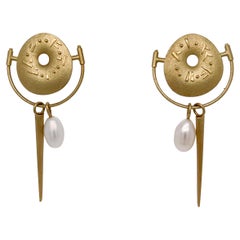Amy Roper Lyons
20th Century American Artisan Drop Earrings
Pearl, Gold, 18k Gold
The Legacy of Pearl in Jewelry Design
The pearl has been synonymous with ladylike elegance since the Tudor period — learn what to look for when shopping for vintage and antique pearl jewelry as well as how to tell the origin of a pearl with our handy primer.
Every woman at some point in her life desires a simple strand of pearls. They are elegant, timeless, versatile — just ask Coco Chanel or Jacqueline Kennedy — and valuable. In 1917, Pierre Cartier famously traded a double-strand of natural pearls for a Fifth Avenue mansion, the Cartier brand’s flagship store ever since. And if you were born in the beginning of summer, pearl is the June birthstone.
It is possible to tell where a pearl originated from its appearance. Akoyas are usually round and white — the classic pearl, if you will. South Sea pearls are normally larger and vary in color; orangey yellow ones are not uncommon. Tahitian pearls are mostly black but can also be gray or brown, and between the Akoya and the South Sea varieties in size. Freshwater pearls, or Orientals, run the gamut in terms of color and size, but in shape, they tend to resemble Rice Krispies. Another important distinction is a round pearl versus a baroque pearl. A round pearl is self-explanatory, but there are two types of baroque pearls: symmetrical and asymmetrical. In general, the symmetrical variation commands a higher valuation. Within a strand of pearls, uniformity is prized — the more the individual pearls resemble one another, the more valuable the strand.
According to the Gemological Institute of America (GIA), the earliest recorded mention of a pearl was in 2206 BC by a Chinese historian. Centuries later, Christopher Columbus made it a point to visit pearl fisheries during his 15th-century exploration of the Caribbean. Since the late-19th century, the Japanese have been at the forefront of cultivating pearls, when jeweler Kokichi Mikimoto successfully cultured the world’s first pearl in 1893.
On 1stDibs, find vintage and antique pearl necklaces, pearl earrings and other accessories.
Finding the Right Dangle-earrings for You
Earrings have a rich, diverse history, and while there are many types of this accessory to choose from, the dangle style is one of the most enduring designs. Today antique and vintage dangle earrings are timeless adornments that can make any outfit instantly more glamorous.
One of the oldest known pairs of dangle earrings was made of jade between 7,500 and 8,200 years ago in Inner Mongolia. Hoop earrings — of which there have been countless variations — are as old as Ancient Mesopotamia, and Ancient Egyptians wore dangle earrings that had sacred symbolism as part of their jewelry practices. In ancient Rome, dangle earrings with pearls and other precious materials were popular.
Dangle earrings vary in length, but they are all designed to cascade off the ears. Some dangle earrings barely fall past the bottom of the earlobe while others fall low enough to graze the shoulders or even fall past them. During the Renaissance period, women wore up-do hairstyles so they could show off their dangle earrings. Even noblemen joined the trend, donning a sole dangle earring adorned with a pearl.
Georgian women preferred heavy girandole earrings that featured candelabra-like arrangements of precious metal and stones. Dangle earrings in the 19th century were simpler, often featuring a single suspended gemstone in a drop-earring style. Going into the 20th century, screw-back earrings and clip-ons became popular, leading to more minimal stud designs. However, dangle earrings have always come back into fashion.
Whether they are made with diamonds, beads or feathers, dangle earrings are statement pieces reflecting the shifting styles over the years. Find the perfect antique and vintage dangle earrings for any occasion on 1stDibs.
